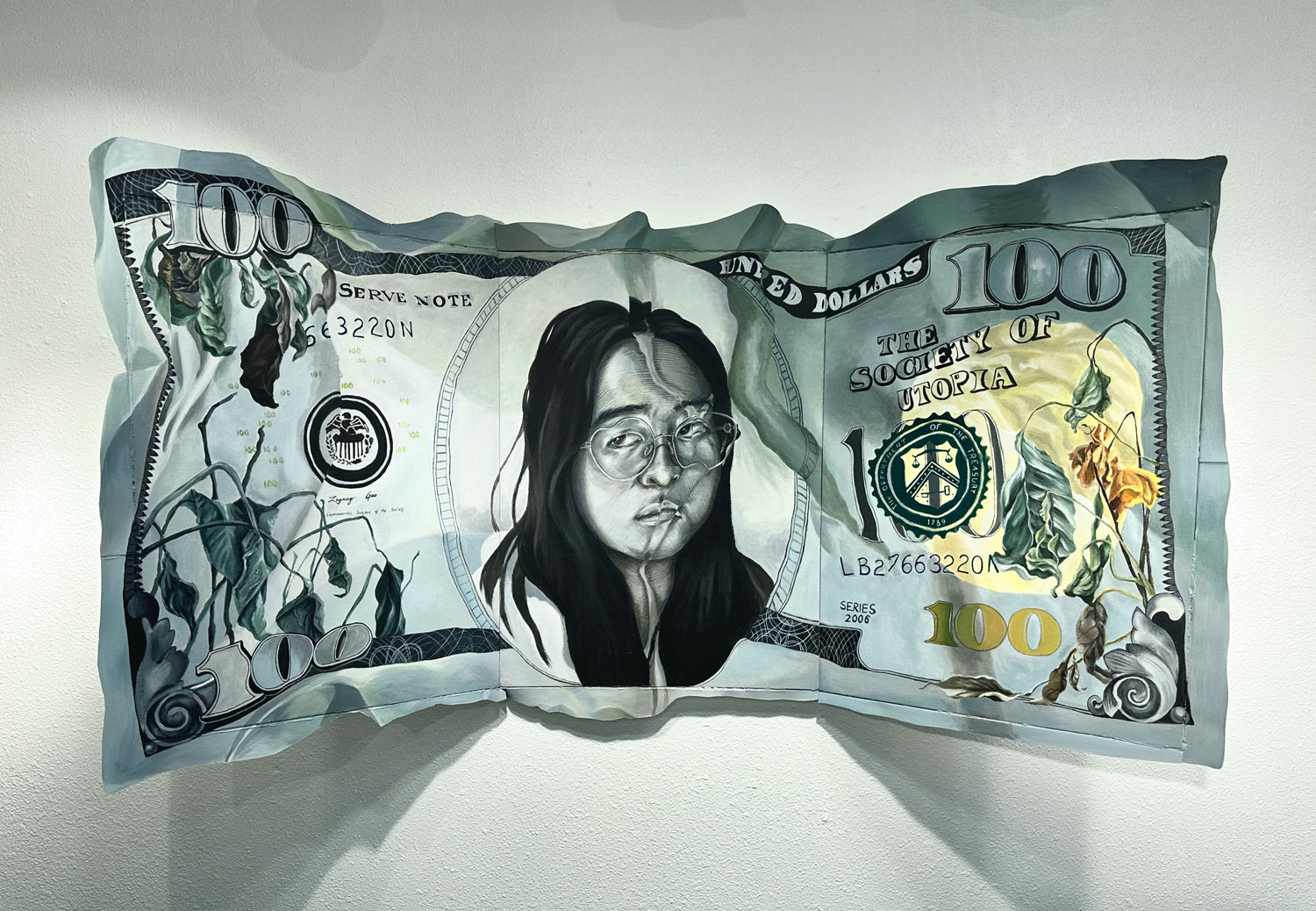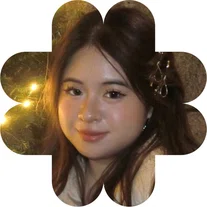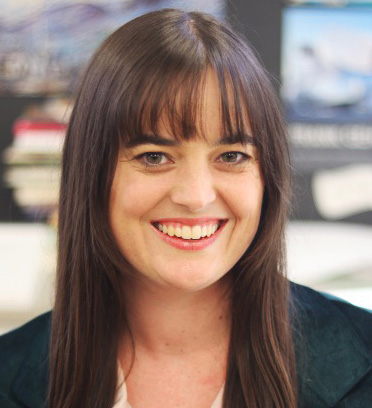

Face Value

Height: 27" x Width: 51" x Depth: 10" | Material(s): Paper cutouts & folded canvases creating an illusive 3D visual; acrylic easy for rendering | Process(es): I extend the subtle yet concentrated rebellion against the arbitrary social hierarchy. | Citation(s): Photographed by my friend
Idea(s): I explored innovative materials, such as using foam board in place of traditional canvas to create irregular shapes. | Curatorial Note: The scale alone of this work is impressive, and the themes challenge yet again the ideals of the nation. The girl at the center of the wrinkled $100bills seems to communicate disappointment as she looks outward; the corners of the bill are filled with overgrown foliage and deterioration.
Ziyang (Nikki) Gao


Student statement
Student statement
Does your work reference or draw on a contemporary or historical art-making style, practice, or tradition? If so, please explain.
My work draws inspiration from Arthur J. Williams Jr.'s $100 bill replication, which the unique way of manipulating the canvas' shape really catches my eye. I got inspired to play with the possibility of the silhouette and push myself to create a three-dimensional picture plane. However, instead of celebrating a historical figure, my little-known face occupies the throne. Since I wanted to explore the value of humanity, I knowingly replaced the common illustrations with that of withering plants, and disrespected the honor given with a side-eye.
How did this artwork relate to your sustained investigation inquiry?
This artwork is a subtle yet concentrated rebellion against the arbitrary hierarchy of our social systems—a structure that makes “profit” the king. It extends this inquiry to the question of which “types” of faces are valued in society, and how these imposed standards disproportionately affect females like me.
In my works, I delve into the profound impact of societal expectations on women's lives. Shaped by relentless scrutiny and propelled by unattainable standards, contemporary women find themselves unwittingly confined within societal constructs, subject to the fleeting whims of public opinion. Through my works, I illuminate the internal struggles faced by women as they endeavor to break free from these confines, challenging the constraints placed upon their physical and mental expressions.
How did your art teacher support your artistic development?
Having a supportive mentor is invaluable—they provide not only constructive advice but also essential emotional support throughout the creative process. I am also deeply grateful for the resources my art teacher has provided, including opportunities to attend art shows and participate in art contests, which have been instrumental in gaining experience as a young artist.
What is your advice to other AP Art and Design students?
Developing a personal style is essential when creating an art portfolio. While mastering drawing and painting techniques is important, it’s equally crucial to prioritize creativity and innovation. Don’t be afraid to take risks—failure is part of the process, and valuable lessons can be learned along the way. Including process images and failed attempts can also add depth and authenticity to the portfolio.

Kearci Moir Thompson
Visual Art Teacher
Portola High School, Irvine, CA, USA
Teacher statement
Teacher statement
How did you scaffold writing into the art-making and thinking processes?
Developing an artwork log assignment helped me to scaffold and spread out the bulk of the writing throughout the year. As students work on or finish an art piece, they add a sentence to their artwork log for the idea; a sentence for their use of materials; a sentence for process; as well as a sentence on how they showcased experimentation, revision, or practice. This document is a big table, with a row for each art piece to keep the writing organized. At a glance, we can quickly see that they need to focus more on revision because they only have boxes filled in for experimentation and practice—allowing students to take ownership of their next steps. I’ve found this makes the thinking process for new pieces less overwhelming, as they can reference their ideas and successes from past pieces quickly to gain inspiration. With Ziyang, this process allowed her to see that she needed to work more with experimentation, leading her to create this artwork that expanded her scope, while finding inspiration from a past artwork to create the idea behind the artwork.
How did you support skill development AND inquiry in the AP Art and Design curriculum?
AP Studio is a class with two prerequisites in our program: Honors Modern Contemporary Art and Advanced Portfolio. Most students take both before joining AP Studio, as in Advanced they are exposed to a variety of materials, subject matter, and styles, which develops their technical skills. In Honors, they are exposed to contemporary art-making practices, developing skills in inquiry. With this scaffolding, when students join AP Studio, they are encouraged to self-select technical skills they want to continue growing in for each piece. For inquiry, we revisit our sustained investigation questions throughout the year, refining, rephrasing, and updating them using contemporary practices gained in previous courses. Ziyang took both of these courses before joining AP Studio, and her introduction to the Guerrilla Girls in Honors inspired her to pursue a sustained investigation of femininity.
What creative programming (i.e., exhibit spaces, mentoring programs, curricular supports) have you implemented to support AP Art and Design students?
Ziyang was a huge part of our creative programming here at Portola High, and this participation helped her succeed as an artist. She served as a member of our Visual Arts Board for a year, planning events like Night of the Arts, the opening night of our annual gallery showcase on campus. AP Studio students select, prepare, and install their artwork in the gallery, getting a board of 6 feet by 5 feet to arrange their artwork and curate their space. Faculty members on campus give out awards for this showcase, and Ziyang won the coveted Best in Show award for her overall body of work. Her work was also featured and awarded at the Irvine Unified District Honors Showcase and Irvine City Hall. She won our Senior Excellence award, the top senior in all Visual Arts, for her outstanding work in fine arts as well as ceramics. These programs and accolades allow AP Studio students to not only display their work for public viewing but also celebrate their dedication and craft. They act as motivation to complete artwork, especially for students who may work more slowly on their projects.
What did you learn from working with your student?
The main thing I learned from Ziyang is the inherent joy in creating. A master experimenter, she is often drawn to mixed media work, consistently trying out new materials, ideas, and methods in her artworks. Her thoughtfulness lends itself to making self-expressive pieces about her inner thoughts and the outer world. I’m always impressed by her technical skills and her ability to weave personal narratives into her stunning visuals. Ideation and actualization of artworks are both strong skills of Ziyang, which in my experience is rare at her age. Her curiosity makes her a resourceful artist and art historian. I knew whenever I saw her on my roster that she was going to make that class period one marked by discussion, collaboration, and thoughtfulness, as her passion for art impacts those around her, including me.

John Pehrson
Portola High School, Irvine, CA, USA
Teacher statement
Teacher statement
What are you most proud of regarding your school’s AP Art and Design program, student, and teacher?
The passion of the teacher and the students is inspiring. The artwork that is produced is a strong reflection of personal experience, beliefs, and dreams. Mrs. Thompson works to empower the artists she works with and encourages all of them to push their limits.
What do you do to support visual arts programming in your school?
Portola works with the arts department to build a schedule that meets the needs of students. We see it as our responsibility remove barriers for students as the pursue their passion and to celebrate their success once achieved. We support annual art fairs and work with the teachers to find ways to display, honor, and award the work whenever we can.
What is your advice to other school leaders on how to support an AP Art and Design program?
Advice to other schools would be to include the art teachers in decision making on how to best honor and celebrate artists on the campus. Reflect on what barriers might need to be taken down and what supports might need to be added to encourage and inspire the artists in every school.

Ziyang (Nikki) Gao

